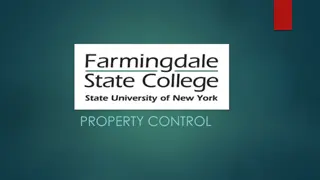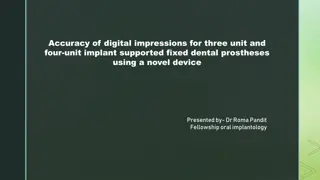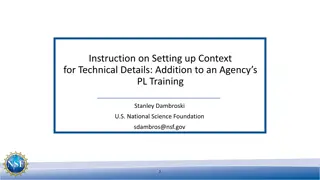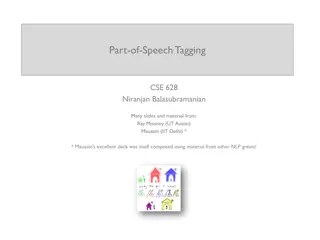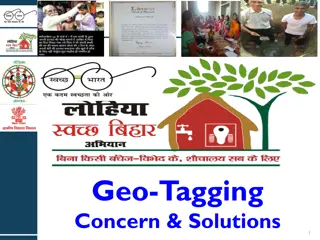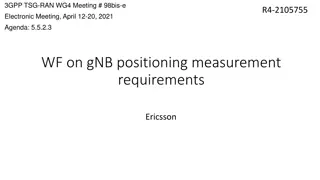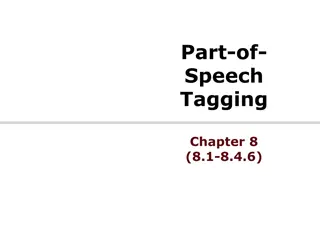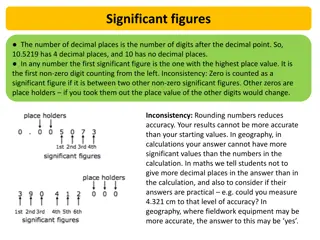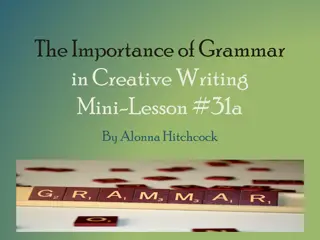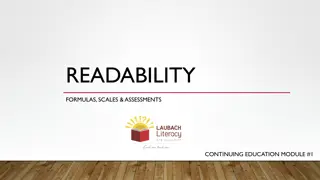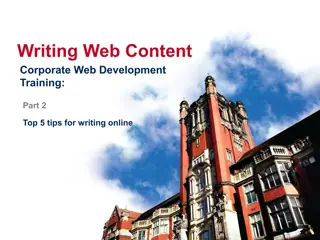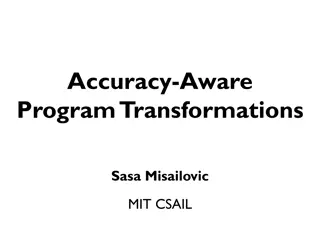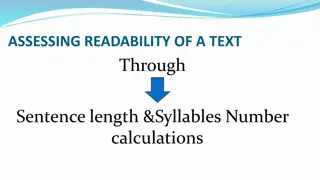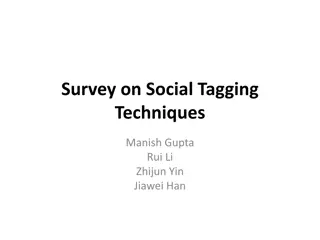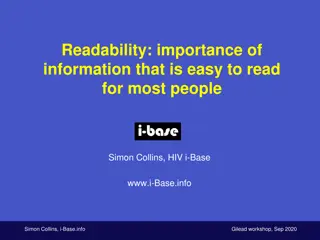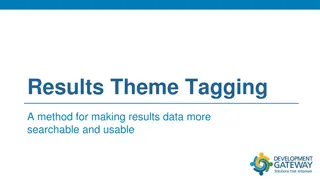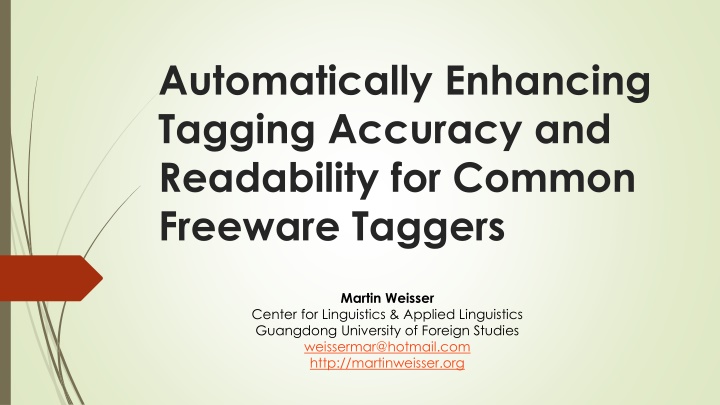
Enhancing Tagging Accuracy and Readability for Freeware Taggers
Explore ways to improve tagging accuracy and readability in freeware taggers, addressing issues such as limited tagsets, complex abbreviations, and minimalistic tag categories. The Tagging Optimiser tool and strategies for enhancing tagset readability and diversifying tag categories are discussed, offering solutions to common challenges faced by linguistics projects using freeware taggers.
Download Presentation

Please find below an Image/Link to download the presentation.
The content on the website is provided AS IS for your information and personal use only. It may not be sold, licensed, or shared on other websites without obtaining consent from the author. If you encounter any issues during the download, it is possible that the publisher has removed the file from their server.
You are allowed to download the files provided on this website for personal or commercial use, subject to the condition that they are used lawfully. All files are the property of their respective owners.
The content on the website is provided AS IS for your information and personal use only. It may not be sold, licensed, or shared on other websites without obtaining consent from the author.
E N D
Presentation Transcript
Automatically Enhancing Tagging Accuracy and Readability for Common Freeware Taggers Martin Weisser Center for Linguistics & Applied Linguistics Guangdong University of Foreign Studies weissermar@hotmail.com http://martinweisser.org
Outline Motivation Typical freeware tagger output Enhancing the readability of the tagset Diversifying tag categories Correcting probabilistic errors The Tagging Optimiser Conclusion 2 of 12
Motivation PoS tagging an essential part of many linguistics projects commercial taggers too costly for smaller-scale, non-funded, projects freeware taggers useful, but with certain drawbacks usu. command-line based possibly difficult to set up/configure (e.g. setting classpath for Stanford Tagger) little control over existing GUIs tagset too limited for fine-grained grammatical analysis tagsets (somewhat) difficult to read/remember errors based on probabilistic approaches 3 of 12
Typical freeware tagger output differences in tag assignment Simple PoS Tagger TagAnt Tagger Stanford (TreeTagger vertical format) Word 1 THE_DT THE_DET THE DT the Word 2 CLAIMS_VBZ CLAIMS_VBZ CLAIMS NN CLAIMS Word 3 OF_IN OF_IN OF IN of Word 4 A_DT A_DET A DT a Word 5 DOG_NN DOG_NNP DOG NP Dog tab format + lemma underscore format slight differences in tag labels 4 of 12
Enhancing the readability of the tagset traditional tags generally consist of 3-4 characters, usu. comprising first character for base category (e.g. N for nouns, V for verbs) additional characters for sub-specification (as applicable) problems need to remember & expand sometimes complex abbreviations using initial as mnemonic for base category not always possible, due to overlap in initials (e.g A for article, adjective & adverb) solutions expand base category names suitably Adj, Adv, Noun, Verb mark sub-specification via ~, e.g. Adj~comp, Verb~modal generally facilitate expansion through longer abbreviations 5 of 12
Diversifying tag categories (1) Issues original Penn Treebank categories used by freeware taggers geared towards parsing hence minimalistic (48 tags only) few sub-distinctions conflation of categories, e.g. IN for prepositions & subordinating conjunctions 13 reserved for punctuation or special characters less suitable for more fine-grained grammatical analyses many useful distinctions, such as between coordinating and subordinating conjunctions, or subject and object pronouns, not present suitability for tagging spoken language limited, e.g. interjections, discourse markers & response signals conflated under UH tag 6 of 12
Diversifying tag categories (2) Solutions distinguish between main categories conjunctions and prepositions to as Inf marker and preposition adjectives and ordinal numbers distinguish between different sub-categories determiners: definite, indefinite, demonstrative verbs: BE-, DO- & HAVE-forms treated/marked differently from general verbs pronouns: include case roles as much as possible mark discourse-relevant features more clearly, identifying discourse markers (DM) minimal yes-/no-responses (Resp~yes & Resp~no) interjections (Interj) 7 of 12
Correcting probabilistic errors (1) reasons according to Manning (2011) 97% top accuracy generally reported = token accuracy in contrast, sentence accuracy [ ] around 55 57% reasons to be found at different levels in tagger design/annotated training materials gaps in the lexicon unknown words errors where the tagger ought to plausibly be able to identify the right tag errors that may require more linguistic context underspecified or unclear tag examples inconsistent or no standard wrong gold standard 8 of 12
Correcting probabilistic errors (2) examples of corrections our_PRPS hero_NN committed_VBN a_DET cardinal_NN sin_NN committed_Verb~past They_PRP disgust_NN and_CC please_VB us_PRP disgust_Verb~not3s the_DT pleasant_JJ trickle_VB of_IN Glenlivet_NNP Double_JJ Malt_NN trickle_Noun~Sing manhood_NN blighted_JJ with_IN unripe_NN disease_NN blighted_Verb~ppart and_CC that_IN glorious_JJ sound_NN which_WDT only_RB our_PRP$ British_JJ amateur_JJ choruses_NNS produce_VBP that_Det~demSing 9 of 12
The Tagging Optimiser extension selector editor pane I/O workspaces 10 of 12
Conclusion first attempt at improving output, but room for improvement by making use of the best probabilistic freeware taggers have to offer diversifying tag categories further by establishing more contextual rules increasing tag precision by taking into account more contextual clues, e.g. for underspecified forms need for community feedback on performance and suitability of tagset, perhaps working towards a new community standard version 1.0 will be downloadable from http:/martinweisser.org/ling_soft.html#tagOpt by early October 2018 11 of 12
References Anthony, L. (2015). TagAnt (Version 1.2.0) [Computer Software]. Tokyo, Japan: Waseda University. Available from http://www.antlab.sci.waseda.ac.jp/. Fligelstone, S., Rayson, P., and Smith, N. (1996). Template analysis: bridging the gap between grammar and the lexicon. In J. Thomas & M. Short (Eds.). Using corpora for language research. London: Longman. 181 207. Garside, R. and Smith, N. (1997). A hybrid grammatical tagger: CLAWS4. In R. Garside, G. Leech, & T. McEnery (Eds.) Corpus Annotation: Linguistic Information from Computer Text Corpora. London: Longman. 102 121. Manning, C. (2011). Part-of-Speech Tagging from 97% to 100%: Is It Time for Some Linguistics? In A. Gelbukh (Ed.). Proceedings of the 12th international conference on Computational linguistics and intelligent text processing (CICLing 11). 171 189. Duibh n, C. (2017). Windows Interface for Tree Tagger. [Computer Software]. Available from http://www.smo.uhi.ac.uk/~oduibhin/oideasra/interfaces/winttinterface.htm. Schmid, H. (1994). Probabilistic Part-of-Speech Tagging Using Decision Trees. Proceedings of International Conference on New Methods in Language Processing, Manchester, UK. 12 of 12

